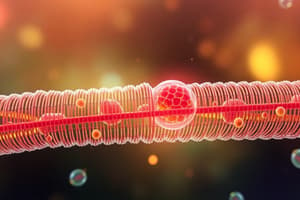Podcast
Questions and Answers
What is the main purpose of the cell membrane?
What is the main purpose of the cell membrane?
Isolation
How does the cell membrane regulate movement of substances?
How does the cell membrane regulate movement of substances?
Through specialized protein structures called transporters
Why is the cell membrane referred to as a double barrier?
Why is the cell membrane referred to as a double barrier?
To ensure only certain molecules are allowed access to the cell
What is the function of the protein pumps in the cell membrane?
What is the function of the protein pumps in the cell membrane?
How does the cell membrane ensure complete removal of molecules leaving the cell?
How does the cell membrane ensure complete removal of molecules leaving the cell?
Explain the role of the cell membrane in protecting the cell.
Explain the role of the cell membrane in protecting the cell.
What is the primary function of the cell membrane?
What is the primary function of the cell membrane?
Describe the structure of the cell membrane.
Describe the structure of the cell membrane.
How do lipids contribute to the barrier function of the cell membrane?
How do lipids contribute to the barrier function of the cell membrane?
Explain the role of proteins in the permeability of the cell membrane.
Explain the role of proteins in the permeability of the cell membrane.
How do proteins contribute to communication between cells?
How do proteins contribute to communication between cells?
Why is the cell membrane also known as the plasma membrane?
Why is the cell membrane also known as the plasma membrane?
Study Notes
Cell Membranes and Plasma Membranes
The cell membrane is often referred to as the plasma membrane because it encloses all living cells except bacteria. This thin layer of lipids wraps around every cellular organelle, separating them from each other within a cell and providing a boundary between the internal environment of the cell and its external surroundings. The primary functions of the cell membrane can be explored through examining both its structural characteristics and its role in maintaining the life processes of the cell.
Structure
At the core of understanding the cell membrane's function lies its basic structure. It consists of a phospholipid bilayer with proteins embedded within it. Lipids act like building blocks, forming layers of fatty acids with hydrophilic heads pointing towards each side and hydrophobic tails facing away from water. These layers create a barrier between the interior and exterior environments of the cell, preventing small molecules such as oxygen and carbon dioxide from freely entering or exiting the cell while allowing larger molecules, including nutrients, to passively diffuse across it.
Proteins play an essential role in the permeability of the membrane. They have various shapes and sizes which determine their ability to transport selective substances through the membrane. For instance, some proteins serve as channels that allow specific ions or polar molecules to move across the membrane, facilitating communication between cells. Others work as receptors, detecting signals outside the cell to initiate intracellular changes. Protein pumps also help maintain the concentration gradient by actively moving substances against their concentration gradients.
Function
The main purpose of the cell membrane is isolation—it keeps everything inside and protects the contents from damage while keeping out potential threats like pathogens and foreign materials. Additionally, it regulates what goes into and comes out of the cell using specialized protein structures called transporters. When a substance enters the cell via these transporters, it must cross two separate lipid barriers; this double barrier ensures that only certain molecules are allowed access to the cell. Furthermore, when a molecule leaves the cell, it hopefully does so via one of the special exit mechanisms designed to ensure complete removal rather than leaking out randomly.
In summary, the cell membrane plays a critical role in protecting and regulating the cell's activities. Its unique structure allows it to control the passage of substances into and out of the cell while maintaining separation from the surrounding environment. Understanding the complexity of the cell membrane provides valuable insights into how cells communicate and interact with their surroundings.
Studying That Suits You
Use AI to generate personalized quizzes and flashcards to suit your learning preferences.
Description
Explore the structural characteristics and functions of cell membranes, also known as plasma membranes, which play a crucial role in protecting cells and regulating the passage of substances. Learn about the phospholipid bilayer, proteins embedded within the membrane, and how they work together to maintain the cell's internal environment.




